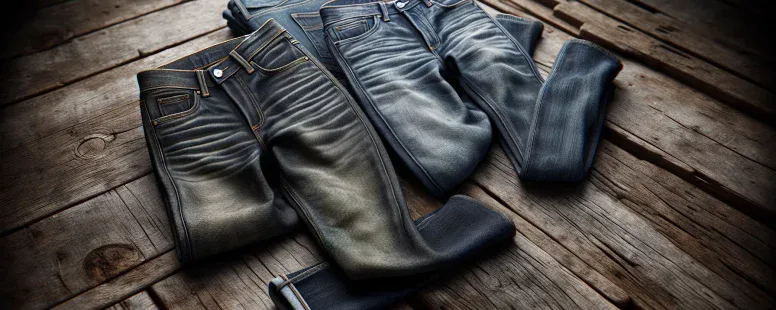Levi’s 501 vs 505: What’s the Real Difference Between Levi’s 501 and 505 Jeans?
Picture yourself rifling through a sea of denim—soft cotton brushing your fingertips, the faint scent of indigo lingering in the air. You spot two iconic pairs: Levi’s 501 and 505. Both promise that classic, rugged look, but beneath the surface lies a story of subtle rebellion and quiet comfort. Which one will fit your style, your stride, your story?
You might think jeans are just jeans, but the difference between these two legends can change the way you move through your day. From the way they hug your hips to the vibe they send with every step, 501 and 505 each offer something distinct—something you won’t want to miss. Immerse and discover which pair will become your new everyday essential.
Overview of Levi’s 501 and 505 Jeans
You find Levi’s 501 and 505 jeans appearing everywhere, from city streets to backstage green rooms. Both models anchor the brand’s heritage but reveal distinctive traits when you investigate deeper. Levi’s 501 jeans sit at the core of American denim history, tracing roots back to 1873, with button fly fastening and straight-cut legs. Wearers like Marlon Brando and Steve Jobs shaped the cultural image of the 501, making it a symbol for rebels and tastemakers. When you slip into a 501, the sturdy weight and mid-rise hit promise durability and timelessness; your movements echo a century of craft.
505 jeans, launched in 1967, introduce a new narrative. Zipper fly replaces the classic button fly, offering convenience you hear about in every modern denim user anecdote. The 505’s slightly more relaxed, straight-leg fit invited people in New York’s punk scene—think Ramones, 1970s—to redefine denim, turning workwear into statement wear. Your silhouette in a 505 sits less snug at the hip yet still provides a structured look; you get freedom without looking baggy.
Consider a night out—would a straight-from-the-box 501 limit your late-night moves, or does the broken-in fabric remember every adventure? Does fast access with the 505’s zipper make them your festival staple? Levi’s uses 100% cotton for most 501 jeans, exemplifying traditional denim, while 505 jeans sometimes come in blends for a bit of stretch. Your choice becomes part of the story—one rooted in old Western trails or pulsing with urban rhythm.
Look at the details—copper rivets in the 501 connect directly to the original Levi’s patent (US Patent No. 139,121, 1873), while the 505’s construction lets you blend comfort and edge in the same garment. You may wonder, which model best captures your daily grind or weekend escape? The answer sits in fit, function and the legacy you want to wear.
Key Differences in Fit and Style
Comparing Levi’s 501 and 505 jeans means studying distinctive fit profiles, construction choices and styling options. Their subtle differences shape your silhouette and day-to-day comfort, so knowing the specifics help you pick your best look.
Fit: Straight vs. Regular
Fit distinguishes Levi’s 501 and 505 jeans at first glance. 501 jeans, cut with a straight leg from hip to hem, evoke icons like Steve Jobs, who favored the structured, never-slouchy look. 505 jeans, while almost straight, have a more regular cut—think of a touch more room from hip through thigh, echoing the easygoing punk scene of the ‘70s. In busy city crowds or quiet rural evenings, 501s often stand out on those who want an assertive shape, whereas 505s fit for those who move fast or need a laid-back vibe. Critical observers spot the difference by the drape: if the fabric falls directly in line with the hip, it’s a 501; if there’s a whisper of ease, it’s probably a 505.
Rise and Waist Design
Waist structure and rise reveal another key difference between these models. Levi’s 501 jeans typically present a classic mid-rise with a fitted seat and a traditional button fly. This aspect appeals to those who crave an authentic denim experience or love the tactile routine of fastening a button fly. A question might rise: why choose one fly over another? Zippered flies, like those in 505 jeans, provide quick convenience—a practical asset in public restrooms or backstage green rooms. Casual wearers often favor 505s in energetic settings, where the waistband sits slightly lower, enhancing that relaxed everyday comfort.
Leg Shape and Opening
Leg silhouette and hem finish off the style conversation. 501 jeans, with a uniform straight leg and a 16”-17” leg opening (Levi Strauss & Co., 2023), create an uninterrupted visual line. Savvy stylists appreciate how 501s stack over boots and sneakers, keeping proportions balanced. 505s, on the other hand, feature a slightly wider leg opening, providing both breathing space and room for chunkier footwear or even light layering in cooler months. Picture a street musician in 505s, cuffed over work boots, versus a tech innovator in 501s and crisp sneakers; each jean shapes the narrative in subtle but significant ways. If you’re considering rolling cuffs, 505s allow for a bit more fabric without bulk.
When deciding between Levi’s 501 and 505, fit and style details like these effect how you express yourself—whether you want heritage-inspired structure or a bit more freedom for everyday adventures.
Materials and Construction
Choose between Levi’s 501 and 505 and you’re really deciding between denim heritage and smart modern updates. The 501’s core fabric stays 100% cotton—for example, heavyweight selvedge from Japan or Cone Mills denim from North Carolina, which is rarer now but highly prized by collectors. Your fingers might trace those dense, flat-felled seams and copper rivets, reminiscent of jeans worn by 20th-century railroad workers who needed real workwear. If you grab a pair of 501s off a thrift shop rack, notice, they’re often stiffer at first and break in slow, developing faded whiskers and honeycombs unique too your routine—denim fans argue it’s like a second skin, learning every move you make.
On the other hand, the 505s sometimes switch up the blueprint. Yes, you’ll spot 100% cotton variants, but newer runs use blends like 98% cotton with 2% elastane—stretch woven for cyclists, band musicians, or anyone crouching to tie a child’s shoes on the go. Stitching here appears similar, but you’ll find zip fly construction—quick, easy, and a hallmark of late-60s garment innovation when rock ‘n’ roll and speed met denim. Those bar tacks and reinforced side belt loops? Meant for durability in city commutes and garage jam sessions alike.
Would you want the tough, rigid feel and nostalgic weight of the 501, or does the 505’s performance fabric sound more appealing for fast mornings? One tells your story over years, like rough landscapes etched into its warp and weft—just ask denim historian Paul Trynka or collectors on the r/RawDenim forum, who swap tales of jeans passed down through family. The other adapts, stretches, and flexes with the frenetic pace of contemporary life. If you wonder, can a pair of jeans last decades? Vintage 501s from the ’70s are auctioned worldwide as relics—sometimes for thousands, according to Levi Strauss & Co. archives. Meanwhile, 505s serve up practicality that resonates with today’s creative crowds. Think about which narrative you want stitched into your routine.
Distinctive Features and Iconic Details
Levi’s 501 jeans symbolize enduring Americana, and their button fly might remind you of a typewriter’s deliberate keystrokes—each snap part of the story. Could you picture grabbing your 501s before a big presentation, feeling the reassuring weight of 100% cotton, copper rivets gleaming like antique coins in sunlight? These classic details, from the double-stitched inseams to the red tab shouting, “I’m original,” root your denim in Levi Strauss & Co.’s legacy (Levi’s, 2024). The 501’s straight leg fits as faithful as an old friend, and the five-pocket construction has carried everything from lucky guitar picks to hand-written protest notes since the 1890s. Have you ever tucked your hand inside those pockets and wondered who wore them decades ago?
Jump to Levi’s 505, and you’ll spot a different mood. The metal zipper glides like a subway in New York—efficient, modern, less ritual but more speed. Fans of the Velvet Underground in the 1970s wore 505s, dancing in basements where the guitarist’s fast fingers mirrored the zipper’s mechanical hum (Rolling Stone, 2018). Unlike the 501s, the 505 features a leg opening that’s a bit wider, making it welcoming for chunky boots or rolled cuffs. You might recognize signature elements like the arcuate stitch or leather patch, yet subtle changes in fabric blends deliver more stretch, flexibility—kind of like updating a rock anthem with just enough synth to hook a new audience.
Ask yourself: When you slide into 501s, are you channeling a craftsman’s heritage? Or when you zip up a pair of 505s, do you step into the energy of punk and progress? These jeans accumulate stories—the fraying at the cuff, the indigo fading at the knees—each mark a silent testament to risk and memory. Levi’s never picked favorites; instead, they handed both icons to you, letting details settle the debate on your own stage.
| Model | Fly Type | Leg Opening | Fabric Composition | Iconic Elements |
|---|---|---|---|---|
| 501 | Button | Straight | 100% cotton | Copper rivets, red tab, heritage fit |
| 505 | Zipper | Wider | Cotton blends (incl. stretch) | Functional zipper, flexible cut, 1967 rebel appeal |
(Data: Levi’s US, Rolling Stone, company archives)
What would your denim say if it could talk? Your Levi’s 501 and 505 jeans don’t just clothe—they narrate, sometimes wrong stories or right ones, but always memorable ones.
Which Jean Is Right for You?
Choosing between Levi’s 501 and 505 jeans puts you at a crossroads, where history and modernity intersect on every seam. The 501 stands as a symbol of American rebellion—think late-night bonfires or Jack Kerouac wandering city streets. You feel its story in every copper rivet and hear its legacy in the soft creak of button flys. When you slip on a pair, your mind might drift to Steve Jobs presenting a new gadget or Marlon Brando, cigarette in hand. The straight leg fit—no-nonsense and tailored—tells the world you respect tradition but blaze your own trail.
The 505, in contrast, opens the door to a different era—one where zippers hum with convenience and a more relaxed cut means you’re ready for a punk rock show or an impromptu road trip. The fabric’s elasticity, thanks to elastane blends (Levi Strauss & Co., Materials Guide), moves with you on a busy day, letting you bend, stretch, and leap curbs without a second thought. You might see these jeans crowding the stage in New York’s CBGB, stitched into the fabric of rebellion with the Ramones pounding a furious rhythm in the background.
Preferences shift. Are you drawn to denim that fades with every adventure, deepens its hues with each memory, and rewards patience? The 501’s 100% cotton, aging with you, wears stories like badges. Or, if quick-dry comfort and easier-on, easier-off practicality sounds better—picture the 505, zipper fly ready to respond when late for work or between classes.
Picture your daily rhythm. You ride the subway or hike a hill; does classic rigidity motivate you, or does a little stretch shapes your sense of freedom? The 505 whispers efficiency, the 501 offers ritual—a button fly takes an extra second, a subtle pause that can help ground your day.
In some wardrobes, both styles live side by side. You reach for the 501 on days chasing heritage and the 505 when flexibility trumps nostalgia. Did you ever think denim could prompt so many questions? Each jean speaks, but which story fits you best?
Conclusion
Choosing between Levi’s 501 and 505 jeans comes down to how you want your denim to fit your lifestyle and reflect your story. Whether you lean toward the timeless appeal of the 501 or the modern comfort of the 505 you’re investing in more than just a pair of jeans.
Let your choice speak to your individuality and how you like to show up in the world. Both styles have earned their place in denim history so you really can’t go wrong with either.







